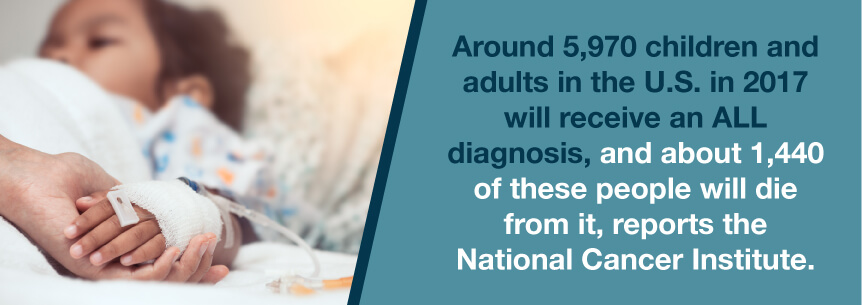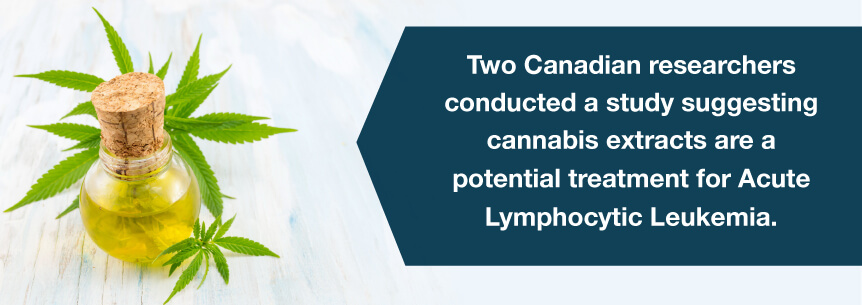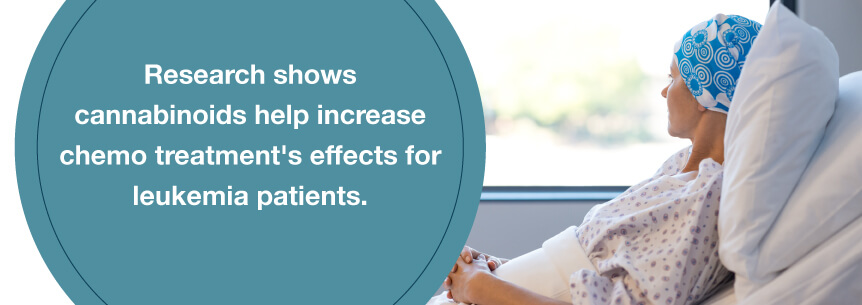Acute lymphoblastic leukemia, or acute lymphocytic leukemia (ALL), is a type of cancer that primarily affects American children and adolescents. ALL makes up around 20 percent of all cancers, with over 6,000 new diagnoses expected this year alone.
Today, we’re seeing increasing evidence and studies linking medical marijuana and cancer in a good way. Many treatment success stories from patients using the herb to treat their cancer reveal this. Now, studies are suggesting medical marijuana leukemia treatment.
ALL originates from your immature bone marrow white blood cells, known as lymphocytes. New blood cells form in your bone marrow. Leukemia cells tend to rapidly invade your blood, often spreading to your other body parts, such as your:
The term “acute” in this form of leukemia means the cancer can rapidly progress if left untreated and could result in death within several months. The term lymphocytic refers to it developing from immature or early lymphocytes.
In many cases, acute lymphocytic leukemia doesn’t have a clear cause. However, specific factors can affect your risk of developing leukemia. These factors include:
Certain factors that can increase your risk of acute lymphocytic leukemia include:
Acute lymphocytic leukemia does occur in adults, but it primarily affects children.
ALL doesn’t typically produce tumor masses, but instead affects the bone marrow. Certain risk factors are common with advanced cases of metastasizing acute lymphocytic leukemia, such as patient age, prognosis, and condition subtype.
Acute lymphocytic leukemia subtypes were initially based on criteria set forth by the French-American-British (FAB) system, however, the World Health Organization’s (WHO) classification system is more robust and is more widely used by oncologists and cancer treatment centers in the United States. Subtypes provide oncologists with critical information to determine appropriate treatment options for patients.
According to WHO, there are three ALL subtypes, L1, L2, and L3. L1 and L2 ALL subtypes are further distinguished by their origin into precursor B lymphoblastic lymphoma or precursor T lymphoblastic lymphoma. L3 includes Burkitt lymphoma, and mature B-cells with abnormalities.
B-lymphoblastic leukemia/lymphoma
T-lymphoblastic leukemia/lymphoma
Treatment is dependent on subtype diagnosis.

Early researchers were first able to reduce ALL symptoms and disease activity or induce temporary remission of acute lymphocytic leukemia with aminopterin, a folic acid antagonist, aminopterin, in a small group of pediatric patients in 1948. By 1961, treatment efficacy reached a 59 percent complete remission rate and an almost 20 percent two-year survival rate in almost 40 pediatric patients by combining methotrexate and mercaptopurine.
It is believed that the ancient Greeks were the first to acknowledge cancer sometime between the fourth and fifth centuries B.C.E. In 1845, the first official leukemia diagnosis occurred in Edinburgh. Cancer has been around for centuries, though this particular disease was hardly recognized before the 20th century. In fact, scientists have found evidence of malignant cancer in fossilized bones, nearly 2 million years old.
Rates for acute lymphocytic leukemia are trending upward, rising 0.3 percent on average annually over the last decade.
The condition also affects the body, not just the cells and blood. Bone pain, frequent infections, bleeding disorders, fatigue, shortness of breath, swollen lymph nodes and pale skin are common. Acute lymphoblastic leukemia causes the following physical symptoms:
Children with ALL bruise and bleed easily, since their blood has low levels of platelets, or clot-forming cells. While it’s uncommon to have major bleeding, there is a chance it could occur in the:
Many ALL treatments can cause infertility. This symptom is usually temporary in most patients, but in some, it could become permanent. You’re at a higher risk of infertility if you’ve received high doses of radiation therapy and chemotherapy to prepare for a bone marrow or stem cell transplant.
Receiving a leukemia diagnosis can be extremely distressing. It may be hard to adjust to at first, especially if symptoms are absent or not severe. Ortunately, modern day leukemia treatments and therapeutics make ALL a treatment and survival condition. Currently, the five-year survival rate is over 70%.
You may feel stressed having to wait several years to see how ALL will develop in you, which can cause severe depression and anxiety. You also may have trouble sleeping.
According to cancer.net, statistics surrounding ALL include:
Based on data from the National Cancer Institute, there are 107,620 people in the U.S. currently living with acute lymphocytic leukemia who survive five years or longer after being diagnosed.

Leukemia is a group of subtypes or related diseases. Because of this, the treatment you get depends on the subtype you have and other factors. You could even have combination treatment, which may include:
Chemo uses a combination of anticancer medications. Standard ALL chemo medications include the following generic and brand names shown in parentheses:
Side effects associated with chemotherapy include hair loss, nausea and vomiting, fatigue, infection, changes in appetite, etc.
Radiation therapy kills cancer cells using high-energy radiation. Radiation therapy has side effects, including skin reactions like rash, dryness, blistering or peeling, shortness of breath, nausea, tooth decay and other effects.
This type of treatment uses medications that target specific cancer cells and doesn’t have the harsh side effects of chemo.
With targeted therapy, high blood pressure, skin problems, such as nail changes, dry skin or rash, gastrointestinal problems, and problems with wound healing and blood clotting can occur.
A bone marrow transplant uses high chemo doses and may include radiation therapy. Bone-forming stem cell transplantation follows it. Sometimes, the stem cells come from either a donor, or the patient’s peripheral blood or bone marrow.
Side effects, such as infections, infertility, organ damage and even death as a result of a bone marrow transplant are common. Therefore, it’s important to discuss treatment risks with a doctor.
An increasing number of studies suggest medical weed can treat cancer and its treatment side effects. More and more anecdotal success stories are popping up about patients using this herb to treat their symptoms. Because of this, medical pot is becoming a popular treatment for cancer. Two Canadian researchers conducted a study suggesting cannabis extracts are a potential treatment for ALL.

In one study, a 14-year-old female patient went through chemo and radiation treatment for 34 months with no response to her severe type of leukemia. After failing standard treatments, her doctors sent her home for palliative care.
Her family learned about cannabis extracts, and having no other options, decided to give hemp oil a try. They learned many studies have shown certain cannabinoid mechanisms kill cancer cells, and started treating her with cannabis oil. Before treatment, doctors measured her cancer levels by her blood leukemic blast cell count.
For a couple of weeks before she received marijuana for acute lymphocytic leukemia treatment, her blast count increased consistently. After five days of cannabis treatment, her count began drastically falling and went from a 374,000 peak to 300 in only 39 days.
In another study, a 3-year-old boy named Landon had ALL. He had leukemia tumors throughout his chest, making it difficult for him to breathe. His cancer progressed rapidly, leading physicians to tell his mother he only had an 8 percent chance of surviving. Doctors started him on chemo, but felt he wouldn’t make it.
After learning about marijuana and acute lymphocytic leukemia treatment, Landon’s mother got his medical marijuana card and started giving him cannabis. He received THC for his nausea and pain and CBD as well. Once she began giving him doses, she said his white and red blood cell count drastically increased. His condition improved to the point where she took him off chemo. After he stopped chemo, she said there were amazing results. He didn’t require any platelet or blood transfusions anymore.
Medical cannabis for acute lymphocytic leukemia can help treat your ALL side effects, such as:
Medical cannabis also induces leukemia cell death. The CBD helps prevent complications in patients receiving a bone marrow transplant or stem cell transplant, lowering their risk of graft-versus-host disease. This complication occurs when transplanted cells attack your body.
Research shows cannabinoids help increase chemo treatment’s effects for leukemia patients. UK researchers found CBD and THC, cannabis’s two major cannabinoids, were highly effective when combined with chemo.

Cancer patients have been turning to medical marijuana to relieve their cancer-treatment related symptoms like pain and nausea. However, recently, researchers are starting to report medical weed slows or even kills cancer cells in some cases. Below is a list of medical cannabis strains found to be therapeutic for ALL patients.
Various marijuana for acute lymphocytic leukemia methods allow you to benefit from cannabis’ potential therapeutic properties for ALL. Along with smoking the herb — which is the unhealthiest method — you can also get your treatment using the following methods:
When it comes to using medical marijuana, you have a lot of consumption options. Therefore, it can be difficult to determine which way of using is the best one to get your treatment for your ALL as new strains and methods become available. You’ll have to experiment and find the consuming option you like best.
Many states have legalized medical cannabis use for qualified health conditions, including cancer. First, however, you need to have a licensed doctor give you a diagnosis of your qualifying health condition and a recommendation for you to get a medical marijuana card. You can do all this easily, just search for a cannabis dispensary or connect with a medical marijuana doctor here on the MarijuanaDoctors.com website. Then you can start realizing the therapeutic effects of cannabis and acute lymphocytic leukemia treatment for yourself.
Find A Doctor Find A Dispensary